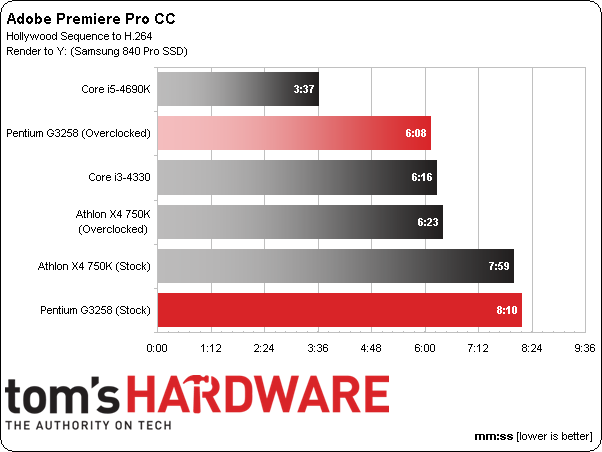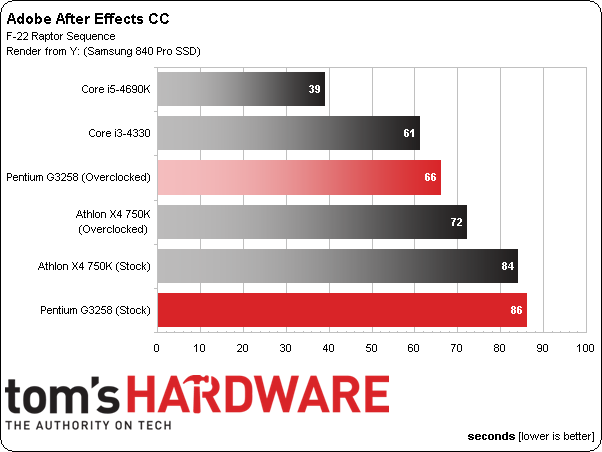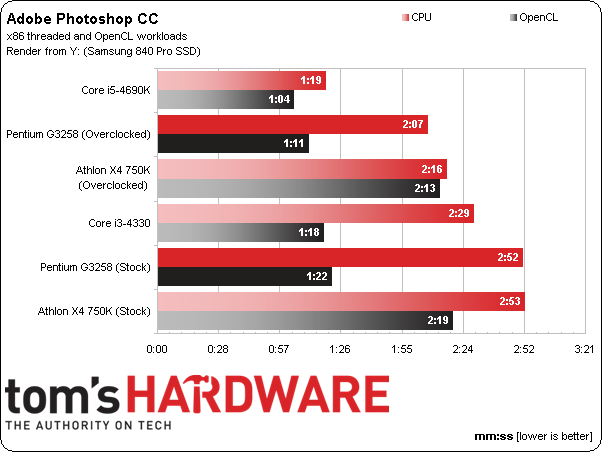Intel Pentium G3258 CPU Review: Haswell, Unlocked, For $75
It's a momentous occasion. Intel now offers an affordable dual-core Pentium with an unlocked multiplier based on its Haswell architecture. How well does it overclock? Can it beat AMD's potent little Athlon X4 750K? We run both through our benchmark suite.
Results: Adobe CC
You wouldn’t expect a straight-up dual-core Pentium to hang with a Hyper-Threaded Core i3 and overclocked dual-module Athlon X4, but there it is.
Again, though, just look at the Core i5 in comparison. And that’s a 3.5 GHz CPU with 800 or 900 MHz of additional headroom available. A quad-core Haswell-based chip (or better) is the way to go when you’re doing heavy lifting.
The same conclusions apply to After Effects. Yes, overclocking does wonders for the Pentium G3258. But Intel’s Core i5 is so much faster. You can shave off 56% of the Pentium’s overclocked result by going with a stock Core i7-4790K if rendering performance really matters to you.
This chart reflects a pair of benchmarks, which need to be looked at separately.
If you run a lot of threaded filters, the red bars matter most. They show Intel’s Pentium G3258 and AMD’s Athlon X4 750K pretty much tied in their stock form. Overclocking helps them both quite a bit, and they both leap past Intel’s $140 Core i3-4330. The extra clock rate favors Intel’s Pentium a little more, though. No matter—if you’re an artist, strongly consider spending more on a quad-core CPU. The Core i5’s finish illustrates why.
Our OpenCL-accelerated numbers are far more problematic for AMD. The Intel CPUs get subtle speed-ups as we shift from stock Pentium to Core i3 to overclocked Pentium, and finally the Core i5. But the overclocked Athlon is 87% slower than the overclock Pentium. Based on what we’ve seen thus far, and knowing this test offloads work to the GeForce card, we have to imagine there’s an issue keeping Nvidia’s GK110 GPU fed on AMD’s platform. The A85X platform only supports PCI Express 2.0, but it’s hard to imagine transfer rates across the PCIe bus making this much difference.
Get Tom's Hardware's best news and in-depth reviews, straight to your inbox.
Current page: Results: Adobe CC
Prev Page Results: Content Creation Next Page Results: Productivity And Media Encoding-
Heironious Article title says its $75, the picture used says its $3 more than the i3. 75 and it's a deal otherwise no point in paying 3 bucks more for it rather than the i3.Reply -
envy14tpe It's always great seeing the full potential of technology but I'd rather see the Pentium on a mobo somebody would really buy and see how overclocking on a budget would be...more realistic.Reply -
silverblue AMD really needs a new model featuring Steamroller cores and a disabled GPU, say, a 770K. It wouldn't change the gaming scores all that much, but various benchmarks would definitely improve. As it is, the G3258 is a nice processor, but it won't go for that $75 to begin with.Reply -
Smallfilou What if "the fool" who bought that Pentium G and Z97 did so expecting to swap the processor in one year or two for a broadwell, once he got the cash? That would make him a very wise fool indeed... I'd say!Reply
Because of course buying a pentium G and fitting it with a 150USD board and 50USD cooler does not make sens by itself ,but you have a 100% future-compatible system that can be upgraded very very easily... -
knowom Could get a Q9550 for that price on Ebay nice try Intel, but that would kick the crap out of that weak Pentium it's reasonably on par with the i5. Way too damn expensive for what it is in reality.Reply -
BoredErica Hyperthreading is typically considered to be bad for Chess. It increases inefficiencies in search and although you get a larger kilonodes per second which looks nice as a benchmark score, you are actually lowering the strength of the engine. So when I look at Fritz benchmarks on PC sites I take them with a grain of salt.Reply -
lunyone I'd probably look at something like this for this kind of CPU:Reply
PCPartPicker part list / Price breakdown by merchant
CPU: Intel Pentium G3258 3.2GHz Dual-Core Processor ($74.99 @ Newegg)
CPU Cooler: Cooler Master Hyper 212 EVO 82.9 CFM Sleeve Bearing CPU Cooler ($30.99 @ Amazon)
Motherboard: ASRock Z87 Pro3 ATX LGA1150 Motherboard ($90.00 @ Newegg)
Memory: G.Skill Ares Series 8GB (2 x 4GB) DDR3-1600 Memory ($75.99 @ Newegg)
Storage: Seagate Barracuda 1TB 3.5" 7200RPM Internal Hard Drive ($52.92 @ Amazon)
Video Card: XFX Radeon R9 280 3GB Double Dissipation Video Card ($209.99 @ Newegg)
Case: Corsair 200R ATX Mid Tower Case ($49.99 @ Newegg)
Power Supply: XFX 550W 80+ Bronze Certified ATX Power Supply ($44.99 @ NCIX US)
Total: $629.86
Prices include shipping, taxes, and discounts when availableGenerated by PCPartPicker 2014-06-17 04:48 EDT-0400 -
Smallfilou Reply13521069 said:Could get a Q9550 for that price on Ebay nice try Intel, but that would kick the crap out of that weak Pentium it's reasonably on par with the i5. Way too damn expensive for what it is in reality.
No, sorry. That is not true. Check this article:
http://www.tomshardware.com/reviews/ivy-bridge-wolfdale-yorkfield-comparison,3487-10.html
You should overclock your Q9550 to get performance that barely comes close to an ivy-bridge I3 on games and lightly threaded workloads (and it gets stomped by any i5 on any workload)... I personally have an OC'd QX9650 and am not even close. I believe if I change to that Pentium G, and overclock it as well, that would still be an upgrade... -
Memnarchon Reply13520870 said:Having looked, the fool would build a cheap pc with that chip and a z97 board, and the wise man would use the i3 and an h81 board. Similar priced systems..
Yeah that would be better unless Intel decides to let o/c on Pentium with other chipsets like H97.
Leaked BIOS Enables Pentium Anniversary Edition OC on Some MSI H97 Boards
MSI H97 PC MATE ATX LGA1150 Motherboard $88.99
So if this happens and intel decide to let even lower mobo chipsets to do o/c only for pentiums it would be nice to pair $60 mobo, $75 CPU and a $25-30 CM 212 EVO or plus, to a total of ~$160 for a o/c ready system.



